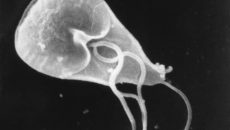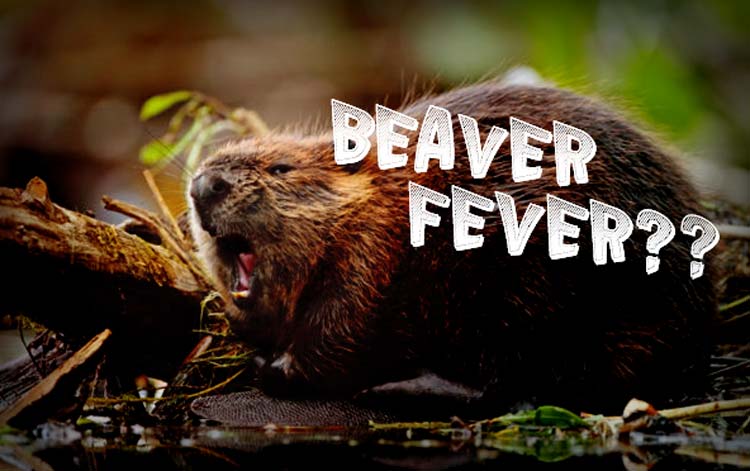 Beaver fever is the common name for giardiasis, the condition brought on by giardia lamblia, which is a protozoan. Giardia lamblia is a complex single-celled organism with a complex life cycle. For part of that cycle it exists as a ‘cyst’ which is a rather durable little packet of dormant life that can survive for months until it is ingested by a host. After it’s swallowed by a muskrat, beaver, or human the parasitic cyst ends up in the stomach, where normal acidic stomach fluids allow the protozoan to hatch, or “excyst”. That’s when the ‘fun’ starts, as the newborn microscopic parasites rapidly replicate. Giardia lamblia soon prevents the host from properly digesting food and absorbing nutrients. Essentially the host experiences terrible diarrhea and, left untreated this can be incredibly disabling or even life-threatening in a survival situation where other stresses and especially poor conditions or injuries may also be involved.
Beaver fever is the common name for giardiasis, the condition brought on by giardia lamblia, which is a protozoan. Giardia lamblia is a complex single-celled organism with a complex life cycle. For part of that cycle it exists as a ‘cyst’ which is a rather durable little packet of dormant life that can survive for months until it is ingested by a host. After it’s swallowed by a muskrat, beaver, or human the parasitic cyst ends up in the stomach, where normal acidic stomach fluids allow the protozoan to hatch, or “excyst”. That’s when the ‘fun’ starts, as the newborn microscopic parasites rapidly replicate. Giardia lamblia soon prevents the host from properly digesting food and absorbing nutrients. Essentially the host experiences terrible diarrhea and, left untreated this can be incredibly disabling or even life-threatening in a survival situation where other stresses and especially poor conditions or injuries may also be involved.
Eating and drinking without being able to absorb nutrients, along with the dehydrating effects of serious diarrhea, make “beaver fever” far from a laughing matter, no matter how funny the common name sounds. Infected water doesn’t even need to be ingested by drinking. Licking your lips after being sprayed by infected, but seemingly clean water can be enough to start the cycle.
Field & Stream recommends these preventative measures:
DOS AND DON'TS
In the vernacular of epidemiologists, giardia's transmission is fecal-oral. The key to prevention, thus, is to create an impenetrable “fire wall” between these two orifices. This is not always as easy as it sounds. Here's how:USE SOAP Wash your hands every time you go to the bathroom. Many diarrheal outbreaks originally thought to have been caused by tainted water have been shown instead to stem from lack of hygiene in food handlers. “You could be blaming a beaver,” says Backer, “when really it's the fingernails of the guy who prepared your food.” If you don't want to waste drinking water to clean your hands, consider carrying an alcohol gel sanitizer.
WHERE TO GO Bury your waste. It's possible to be infected with giardia but never have any symptoms. Like Typhoid Mary, you could be shedding cysts in droves without even knowing it. Always defecate at least 100 feet away from local water sources, then bury it to keep rainwater from washing cysts into the watershed.
WATCH WHAT YOU DRINK Always treat water before drinking. It's impossible to tell from looking at wilderness water if it's safe or not. Bringing water to a full boil is probably your safest bet, because this will kill everything in it. If you can't, filtration with a microfilter can work well, too. Look for a product with a pore size of no more than 1 micron. Another option is treatment with chemicals, especially chlorine or iodine tablets. The latter will not, unfortunately, kill crypto-sporidium, so it's best to use chemicals and a filter if you can't boil the water.
Source: Field&Stream

… beware of what lurks in the waters & at strip clubs on your next outing…???
You could get married…
Isn’t it called pregnancy in some cultures?
I’m 46 and still have it. Although a naked picture of Hillary Clinton has helped tremendously.
Huh
Snicker.
Ice Cream cone.
No man. It starts the moment you take your first sip. Without a change of socks and Motrin, you’ll die within 24 hours. It’s kinda’ a big deal.
Ive had beaver fever since puberty
I caught this and ended up getting married because of it. Never again will I have beaver fever. I always called it$#%&!@*whooped though.
I’ve had beaver fever since I was 13!!! I’m doomed!!! Lmao!!!!
LMFAO!!!!
Life straws are great. Also you can boil any kind of water and put food in a water right cantainer or even a plastic sealable bag and cook your viddles right in the bag or container I cook omelets for breakfast this way when camping it’s easy and fast